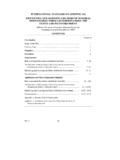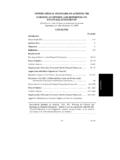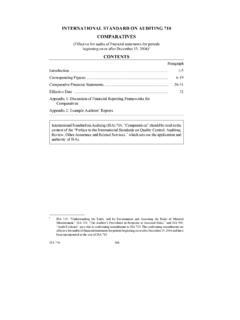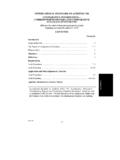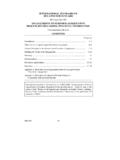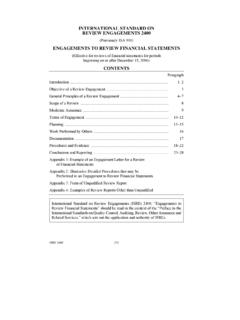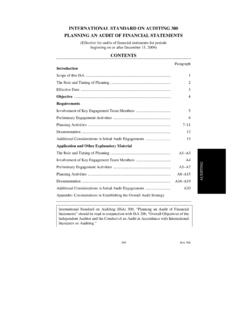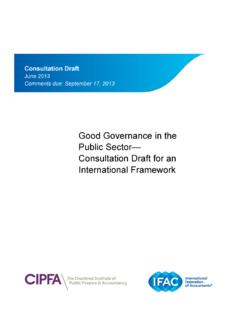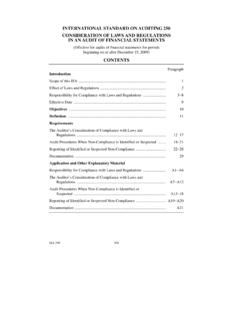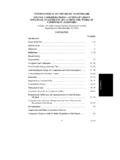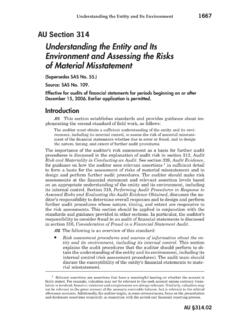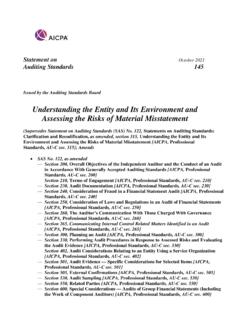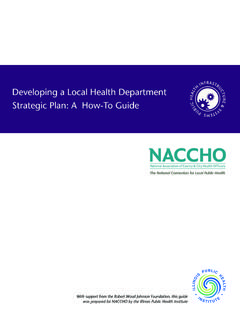Transcription of INTERNATIONAL STANDARD ON AUDITING 315 (REVISED ...
1 IS A 315 (REVISED) 877 AUDITING INTERNATIONAL STANDARD ON AUDITING 315 (REVISED) IDENTIFYING AND ASSESSING THE RISKS OF MATERIAL MISSTATEMENT THROUGH UNDERSTANDING THE entity AND ITS environment (Effective for audits of financial statements for periods ending on or after December 15, 2013) CONTENTS Paragraph Introduction Scope of this ISA .. 1 Effective Date .. 2 Objective .. 3 Definitions .. 4 Requirements Risk Assessment Procedures and Related Activities .. 5 10 The Required Understanding of the entity and Its environment , Including the entity s Internal Control .. 11 24 Identifying and Assessing the Risks of Material Misstatement .. 25 31 Documentation .. 32 Application and Other Explanatory Material Risk Assessment Procedures and Related Activities .. A1 A23 The Required Understanding of the entity and Its environment , Including the entity s Internal Control .. A24 A117 Identifying and Assessing the Risks of Material Misstatement.
2 A118 A143 Documentation .. A144 A147 Appendix 1: Internal Control Components Appendix 2: Conditions and Events That May Indicate Risks of Material Misstatement IDENTIFYING AND ASSESSING THE RISKS OF MATERIAL MISSTATEMENT THROUGH UNDERSTANDING THE entity AND ITS environment IS A 315 (REVISED) 878 INTERNATIONAL STANDARD on AUDITING (ISA) 315 (Revised), Identifying and Assessing the Risks of Material Misstatement through Understanding the entity and Its environment , should be read in conjunction with ISA 200, Overall Objectives of the Independent Auditor and the Conduct of an Audit in Accordance with INTERNATIONAL Standards on AUDITING . IDENTIFYING AND ASSESSING THE RISKS OF MATERIAL MISSTATEMENT THROUGH UNDERSTANDING THE entity AND ITS environment IS A 315 (REVISED) 879 AUDITING Introduction Scope of this ISA 1. This INTERNATIONAL STANDARD on AUDITING (ISA) deals with the auditor s responsibility to identify and assess the risks of material misstatement in the financial statements, through understanding the entity and its environment , including the entity s internal control.
3 Effective Date 2. This ISA is effective for audits of financial statements for periods ending on or after December 15, 2013. Objective 3. The objective of the auditor is to identify and assess the risks of material misstatement, whether due to fraud or error, at the financial statement and assertion levels, through understanding the entity and its environment , including the entity s internal control, thereby providing a basis for designing and implementing responses to the assessed risks of material misstatement. Definitions 4. For purposes of the ISAs, the following terms have the meanings attributed below: (a) Assertions Representations by management, explicit or otherwise, that are embodied in the financial statements, as used by the auditor to consider the different types of potential misstatements that may occur.
4 (b) Business risk A risk resulting from significant conditions, events, circumstances, actions or inactions that could adversely affect an entity s ability to achieve its objectives and execute its strategies, or from the setting of inappropriate objectives and strategies. (c) Internal control The process designed, implemented and maintained by those charged with governance, management and other personnel to provide reasonable assurance about the achievement of an entity s objectives with regard to reliability of financial reporting, effectiveness and efficiency of operations, and compliance with applicable laws and regulations. The term controls refers to any aspects of one or more of the components of internal control. (d) Risk assessment procedures The audit procedures performed to obtain an understanding of the entity and its environment , including the entity s internal control, to identify and assess the risks of material misstatement, whether due to fraud or error, at the financial IDENTIFYING AND ASSESSING THE RISKS OF MATERIAL MISSTATEMENT THROUGH UNDERSTANDING THE entity AND ITS environment IS A 315 (REVISED) 880 statement and assertion levels.
5 (e) Significant risk An identified and assessed risk of material misstatement that, in the auditor s judgment, requires special audit consideration. Requirements Risk Assessment Procedures and Related Activities 5. The auditor shall perform risk assessment procedures to provide a basis for the identification and assessment of risks of material misstatement at the financial statement and assertion levels. Risk assessment procedures by themselves, however, do not provide sufficient appropriate audit evidence on which to base the audit opinion. (Ref: Para. A1 A5) 6. The risk assessment procedures shall include the following: (a) Inquiries of management, of appropriate individuals within the internal audit function (if the function exists), and of others within the entity who in the auditor s judgment may have information that is likely to assist in identifying risks of material misstatement due to fraud or error.
6 (Ref: Para. A6 A13) (b) Analytical procedures. (Ref: Para. A14 A17) (c) Observation and inspection. (Ref: Para. A18) 7. The auditor shall consider whether information obtained from the auditor s client acceptance or continuance process is relevant to identifying risks of material misstatement. 8. If the engagement partner has performed other engagements for the entity , the engagement partner shall consider whether information obtained is relevant to identifying risks of material misstatement. 9. Where the auditor intends to use information obtained from the auditor s previous experience with the entity and from audit procedures performed in previous audits, the auditor shall determine whether changes have occurred since the previous audit that may affect its relevance to the current audit. (Ref: Para. A19 A20) 10. The engagement partner and other key engagement team members shall discuss the susceptibility of the entity s financial statements to material misstatement, and the application of the applicable financial reporting framework to the entity s facts and circumstances.
7 The engagement partner shall determine which matters are to be communicated to engagement team members not involved in the discussion. (Ref: Para. A21 A23) IDENTIFYING AND ASSESSING THE RISKS OF MATERIAL MISSTATEMENT THROUGH UNDERSTANDING THE entity AND ITS environment IS A 315 (REVISED) 881 AUDITING The Required Understanding of the entity and Its environment , Including the entity s Internal Control The entity and Its environment 11. The auditor shall obtain an understanding of the following: (a) Relevant industry, regulatory, and other external factors including the applicable financial reporting framework. (Ref: Para. A24 A29) (b) The nature of the entity , including: (i) its operations; (ii) its ownership and governance structures; (iii) the types of investments that the entity is making and plans to make, including investments in special-purpose entities; and (iv) the way that the entity is structured and how it is financed, to enable the auditor to understand the classes of transactions, account balances, and disclosures to be expected in the financial statements.
8 (Ref: Para. A30 A34) (c) The entity s selection and application of accounting policies, including the reasons for changes thereto. The auditor shall evaluate whether the entity s accounting policies are appropriate for its business and consistent with the applicable financial reporting framework and accounting policies used in the relevant industry. (Ref: Para. A35) (d) The entity s objectives and strategies, and those related business risks that may result in risks of material misstatement. (Ref: Para. A36 A42) (e) The measurement and review of the entity s financial performance. (Ref: Para. A43 A48) The entity s Internal Control 12. The auditor shall obtain an understanding of internal control relevant to the audit. Although most controls relevant to the audit are likely to relate to financial reporting, not all controls that relate to financial reporting are relevant to the audit.
9 It is a matter of the auditor s professional judgment whether a control, individually or in combination with others, is relevant to the audit. (Ref: Para. A49 A72) Nature and Extent of the Understanding of Relevant Controls 13. When obtaining an understanding of controls that are relevant to the audit, the auditor shall evaluate the design of those controls and determine whether IDENTIFYING AND ASSESSING THE RISKS OF MATERIAL MISSTATEMENT THROUGH UNDERSTANDING THE entity AND ITS environment IS A 315 (REVISED) 882 they have been implemented, by performing procedures in addition to inquiry of the entity s personnel. (Ref: Para. A73 A75) Components of Internal Control Control environment 14. The auditor shall obtain an understanding of the control environment . As part of obtaining this understanding, the auditor shall evaluate whether: (a) Management, with the oversight of those charged with governance, has created and maintained a culture of honesty and ethical behavior; and (b) The strengths in the control environment elements collectively provide an appropriate foundation for the other components of internal control, and whether those other components are not undermined by deficiencies in the control environment .
10 (Ref: Para. A76 A86) The entity s risk assessment process 15. The auditor shall obtain an understanding of whether the entity has a process for: (a) Identifying business risks relevant to financial reporting objectives; (b) Estimating the significance of the risks; (c) Assessing the likelihood of their occurrence; and (d) Deciding about actions to address those risks. (Ref: Para. A87) 16. If the entity has established such a process (referred to hereafter as the entity s risk assessment process ), the auditor shall obtain an understanding of it, and the results thereof. If the auditor identifies risks of material misstatement that management failed to identify, the auditor shall evaluate whether there was an underlying risk of a kind that the auditor expects would have been identified by the entity s risk assessment process. If there is such a risk, the auditor shall obtain an understanding of why that process failed to identify it, and evaluate whether the process is appropriate to its circumstances or determine if there is a significant deficiency in internal control with regard to the entity s risk assessment process.
